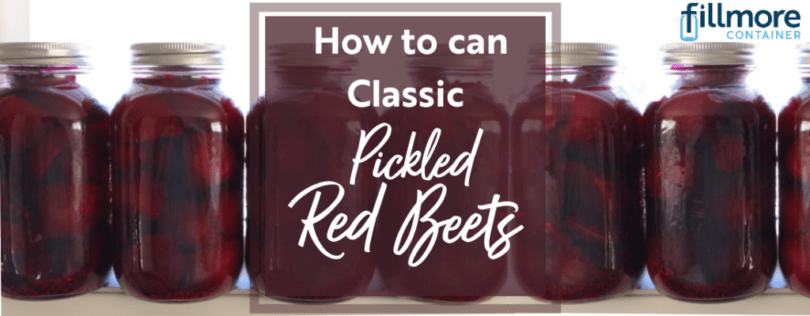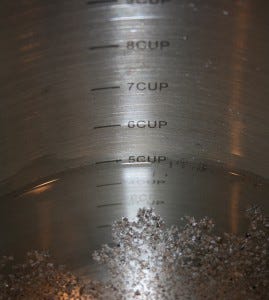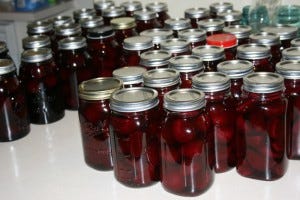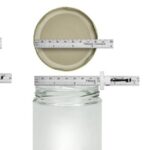
Pickled Red Beets – a Classic Recipe for Water Bath Canning
(Updated July 6, 2020)
Pickled red beets are a childhood favorite of mine, so we’re sharing the recipe…Pickled Red Beets – a classic recipe for water bath canning. Ever since I can remember, they’ve had a prominent place on the relish platter whenever our family gathered! My mother will still happily put up whatever amount of beets come her way, knowing that her kids & grandkids will devour them. Last autumn around this time, I got the somewhat concerned mother’s call that my father had come home from the local produce auction with a pick-up truck filled with beets. I headed right over…because beets were special…and for some crazy reason, I really like peeling them and I knew it would be worth a day of steady work.
When dealing with such a large volume of beets, we had to prep the jars in stages. We gathered all the lids, prepared our large water bath canner, and ran our clean canning jars through the steam cycle of the dishwasher to warm them up while prepping the beets.
 My father was in charge of the outside work, His usual system was to hose them off well, then cook them in the turkey fryer. After the beets were sufficiently cooked (easily stuck with a fork) he lifted out the basket and dumped them into a very large metal bowl and would bring them in for me to peel. Before starting the next batch, my Mother would retrieve some of the beet juice for the pickling brine using her 4th Burner Pot. It’s the perfect pot for this because its silicone handles make it easy to carry, and it has measurement markings inside the pot. She never wanted to waste those nutrients and that bright hue.
My father was in charge of the outside work, His usual system was to hose them off well, then cook them in the turkey fryer. After the beets were sufficiently cooked (easily stuck with a fork) he lifted out the basket and dumped them into a very large metal bowl and would bring them in for me to peel. Before starting the next batch, my Mother would retrieve some of the beet juice for the pickling brine using her 4th Burner Pot. It’s the perfect pot for this because its silicone handles make it easy to carry, and it has measurement markings inside the pot. She never wanted to waste those nutrients and that bright hue.
Since my mother likes to use smaller pickled red beets (small enough to be quartered or halved) for her relish trays, I’d set those lovely little specimens aside so we could process them together as to keep track of them. The larger beets got halved or quartered with an effort to keep some consistency in size.
Our family recipe is as basic as it gets for pickling. Some folks like to add some extras…and they’re good too! You might want to consider bundling some of your favorite pickling friendly spices like cinnamon & whole cloves or caraway seeds black peppercorns into a cheesecloth spice bag. Allow spices to infuse into the brine during cooking, but remove the bag before adding the beets.
Here is the Brine Recipe that my Mother got from her Mother.
The amount of brine you’ll need will depend on the size of your beets – more specifically, the amount of space in the jar that isn’t occupied by the beets.
- 3 Cups Red Beet Water (the water in which the beets were initially cooked)
- 1 Cup Vinegar
- 1 tsp Salt
- 1 Cup Sugar
- Pepper is optional
- Use our 4th Burner Pot (or a large pitcher) to mix batches of the brine. This makes it easy to add to the beets in your kettle as needed and to top off jars during filling.

- In a large kettle bring the brine and the prepped beets to a boil; allow to boil 15 minutes.
- With a slotted spoon, ladle the beets into hot jars, allowing a generous 1/2 inch headspace.
- Ladle the hot brine into the jar, over the beets. Remove any air bubbles and adjust headspace if needed.
- Wipe rim, carefully center lid on the jar, apply ring and finger-tip tighten.
- Put jars into the water bath canner and check the water level. You should have a good inch of water above the lids for this duration of processing. When doing multiple batches, be sure to check this between each batch, as water will be lost with each batch.
- Bring to a boil and process at a roiling boil for 30 minutes.
Adjustment for Altitude: based on Hot Pack for Pints or Quarts
- 0 – 1,000 ft : 30 minutes
- 1,001 – 3,000 ft : 35 minutes
- 3,001 – 6,000 ft : 40 minutes
- Above 6,000 ft : 45 minutes
Remove canner lid and allow to sit for 5 minutes, then carefully remove the jars from the canner using a jar lifter, setting them on a towel-lined counter. Let them set until completely cool. Remove rings and store in a cool place.






Absolutely great!
I must admit that I had never heard of using Caraway seeds in this way, voted up! cheers nell
Can I substitute Splenda for the sugar?
Hi Tom,
If you’d like to try using splenda in pickled beets, we would recommend using this tested recipe from the National Center for Home Food Preservation. https://nchfp.uga.edu/how/can_06/splenda_pickled_beets.html
I’m curious as to why you say to remove the (optional) spices before adding beets. I’ve always packed them in the jar with the beets, to add extra flavor. Should I not do this?
Thanks, I’m looking forward to making a couple batches.
Hi Cindy, We remove the spices because we pack them in a cheesecloth bag to cook with bring. If you’d like to add cinnamon & whole cloves or caraway seeds, black peppercorns, etc. directly into your jars – that works too. We just prefer to let the spice simmer in with the brine prior to packing the jars. It’s just a personal preference.
Love this recipe!! Getting ready to can another 6 -10 pints!
Can you redo your beets after the beets have been processed in a hot bath method?
Hi Elaine,
You can pickle them and redo the canning, but keep in mind that the more fruits/veggies are cooked, the softer they become.
Hi, many thanks for the recipe. Is it absolutely necessary to “process” the beets in a canner or can they instead be put into a fridge? If they are “unprocessed” what would you estimate their shelf-life to be?
Second question! I have a steam oven. If I do decide to “process” the beets (or other vegetables) for longer preservation, can I apply the same times you give for “hot-pack” and “cold-pack” preserving in a water bath canner?
Many thanks, Steve
Hi Steve,
Unprocessed beets can be stored in the fridge, and because of the vinegar and sugar, will have a reasonable fridge life. From a very unscientific personal experience, I’ve been happy to have some in my fridge for several months as a result of the jar being hidden in the back of the fridge. We would not recommend this as a planned long term storage solution.
Regarding the steam processing…as steam ovens are just recently being introduced into residential kitchens, I am not able to speak on the safety of using that to process beets (or any canned foods). We would recommend reaching out to your local extension office to see how your steam oven would compare to acceptable uses of a steam canner – which has been approved for some limited applications.
Hi Gary, You remove the jars from the canner, allow them to cool completely, then take the bands off before putting them into storage. Bands should not be on jars in storage, as it can mask problems (seal failure) that can arise while in storage. The vacuum created in the canning process should be enough to keep the lids in place.
I can’t print this recipe and I don’t like having my tablet on my kitchen counter. Also, the recipe doesn’t say how many pints it makes. I like to sterilize the jars first before beginning.
Hello Pam, We’re in the process of transferring our recipes to recipe cards which allow for easier printing. As for the yield, because of the variation in the sizes (and the choice to quarter, slice or leave whole) this is only the recipe for the brine. You can multiply it as much as you need for the volume of beet to meet your needs. As you work through the beets, you’ll have to adjust and make more (or not) depending on how much of the brine each jar actually requires. You can sterilize jars before, but if you’re not working in a sterile kitchen, they’re not guaranteed be sterile by the time you fill them. If the water bathing for the proper duration, it’s sufficient to simply start with clean, warm jars.